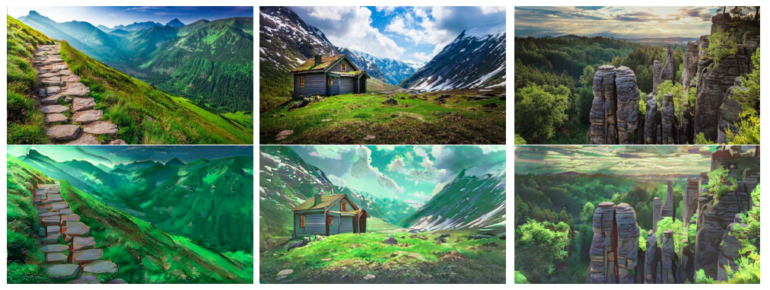TL;DR:
- Researchers propose Scenimefy, a pioneering semi-supervised image-to-image transformation for anime scene rendering.
- Anime scene creation demands creativity and time; Scenimefy automates scene stylization using GANs.
- Prior work focused on faces; Scenimefy bridges the gap between real-world scenes and anime styles.
- Challenges include scene composition, unique anime characteristics, and data domain differences.
- Scenimefy utilizes pseudo-paired data and a novel supervised branch to address limitations.
- Semantic-constrained fine-tuning and data selection enhance style transfer and detail preservation.
- Scenimefy surpasses benchmarks in perceptual quality and quantitative evaluation.
- Implications include elevated anime scene quality and accelerated creative workflows.
Main AI News:
In the realm of artistry, crafting anime sceneries demands an amalgamation of profound creativity and substantial temporal investments. In light of this, the emergence of learning-based techniques for automating scene stylization assumes paramount importance, not only in terms of practicality but also economically. Recent strides in Generative Adversarial Networks (GANs) have notably propelled the realm of automatic stylization, although much of this progress has been centered around human facial attributes. Notably, the pursuit of transmuting intricate real-world scene snapshots into anime styles remains an intriguing avenue yet to be fully explored, despite its profound research potential. This creative endeavor remains multifaceted due to several key factors.
- The Art of Composition: As illustrated in Figure 1, the intricate interplay between foreground and background components within scenes forms a hierarchical arrangement, often composed of interconnected elements that create a complex visual tapestry.
- Distinct Anime Traits: The essence of anime lies in its distinct visual attributes, wherein pre-designed brush strokes intricately embellish natural elements such as grass, trees, and clouds, imparting unique textures and meticulous details that define the genre. The organic, hand-drawn nature of these textures poses a formidable challenge in emulation, in stark contrast to the well-defined lines and uniform color blocks seen in earlier explorations.
- Bridging the Data Gap: Bridging the chasm between real-world scenes and their anime counterparts necessitates a high-quality anime scene dataset, an imperative underscored by the pronounced divergence between these two domains. Regrettably, existing datasets often lean toward lower quality due to the prevalence of human faces and other foreground objects that diverge aesthetically from the backdrop scenery.
In the sphere of unsupervised image-to-image translation, a popular avenue for intricate scene stylization bereft of paired training data, existing methodologies aimed at anime styles still grapple with certain limitations, despite displaying promising results. Notably, the inherent absence of pixel-level correlations within complex scenes poses challenges for current techniques, impeding the seamless integration of textural stylization while retaining semantic significance. This, in turn, can result in outputs that deviate from the norm and showcase conspicuous artifacts. Additionally, some methodologies falter in capturing the intricate minutiae intrinsic to anime scenes, a shortcoming attributed to their adopted anime-specific loss functions or pre-extracted representations, which accentuate edge and surface smoothness at the cost of finer details.
In a stride to surmount the aforementioned hurdles, visionaries hailing from S-Lab at Nanyang Technological University introduce “Scenimefy,” an unprecedented semi-supervised image-to-image (I2I) transformation pipeline engineered to craft superior anime-style renditions of scene photographs. At its core, this innovation hinges on the utilization of generated pseudo-paired data, orchestrating the integration of a novel supervised training facet into the unsupervised framework, thereby addressing the lacunae intrinsic to unsupervised training modalities. Drawing on the advantages of StyleGAN, the researchers finely calibrate it to yield coarse paired data bridging the real and anime domains, augmented by faux-paired data.
Central to their innovation is the deployment of a novel semantic-constrained fine-tuning mechanism, harnessed in conjunction with robust pre-trained model priors like CLIP and VGG. This judiciously guides StyleGAN in encapsulating intricate scene intricacies while mitigating overfitting. To winnow out suboptimal data, a segmentation-guided data selection methodology is proffered. By fusing pseudo-paired data with a bespoke patch-wise contrastive style loss, Scenimefy engenders finer nuances across the two domains, fostering efficacious pixel-level correspondence. The resultant semi-supervised framework masterfully navigates the delicate equilibrium between faithfulness and fidelity in scene stylization, impeccably dovetailing with the unsupervised training arm.
Augmenting their endeavors is the assembly of an expansive, high-caliber dataset comprising pristine anime scenes, strategically positioned to underpin forthcoming investigations into scene stylization. Rigorous trials were executed, spotlighting Scenimefy’s prowess as it surmounted industry benchmarks for perceptual excellence and quantitative assessment. In summation, the ensuing sections delineate the monumental strides achieved by the researchers:
- Novel Semi-Supervised Framework: The inception of a distinctive framework unfurls, one that metamorphoses authentic photographs into intricate anime scene paragons of excellence. Anchoring this system is an ingenious patch-wise contrastive style loss, augmenting stylization and granular details.
- Semantic-Constrained StyleGAN Refinement: A pioneering refinement methodology is unveiled, whereby StyleGAN undergoes strategic fine-tuning fortified by robust pre-trained priors. A complementary segmentation-guided data curation mechanism births structure-consistent pseudo-paired data, serving as the bedrock for training supervision.
- Enriching the Anime Archive: A treasury of high-resolution anime scenes is meticulously curated, poised to invigorate future forays into scene stylization research.
In essence, Scenimefy redefines the landscape of anime scene rendering, ushering in an era of elevated quality and artistic finesse. Through an orchestrated symphony of innovation, this trailblazing endeavor underscores the ever-evolving fusion of technology and aesthetics.
Conclusion:
This groundbreaking research on Scenimefy demonstrates a pivotal advancement in the intersection of technology and artistic creation. By automating the intricate process of anime scene rendering, this innovation stands to reshape the creative landscape, empowering artists and creators with tools that seamlessly blend real-world scenes with anime aesthetics. The market can anticipate a surge in the efficiency of anime production pipelines, leading to heightened visual quality and a more streamlined artistic process. As Scenimefy propels the boundaries of stylization, it catalyzes a paradigm shift that will undoubtedly influence the anime industry, fostering both economic growth and artistic ingenuity.

